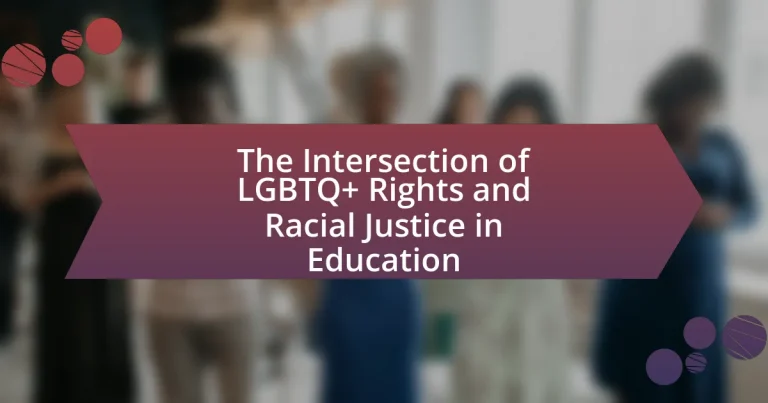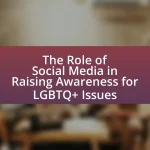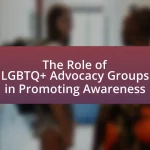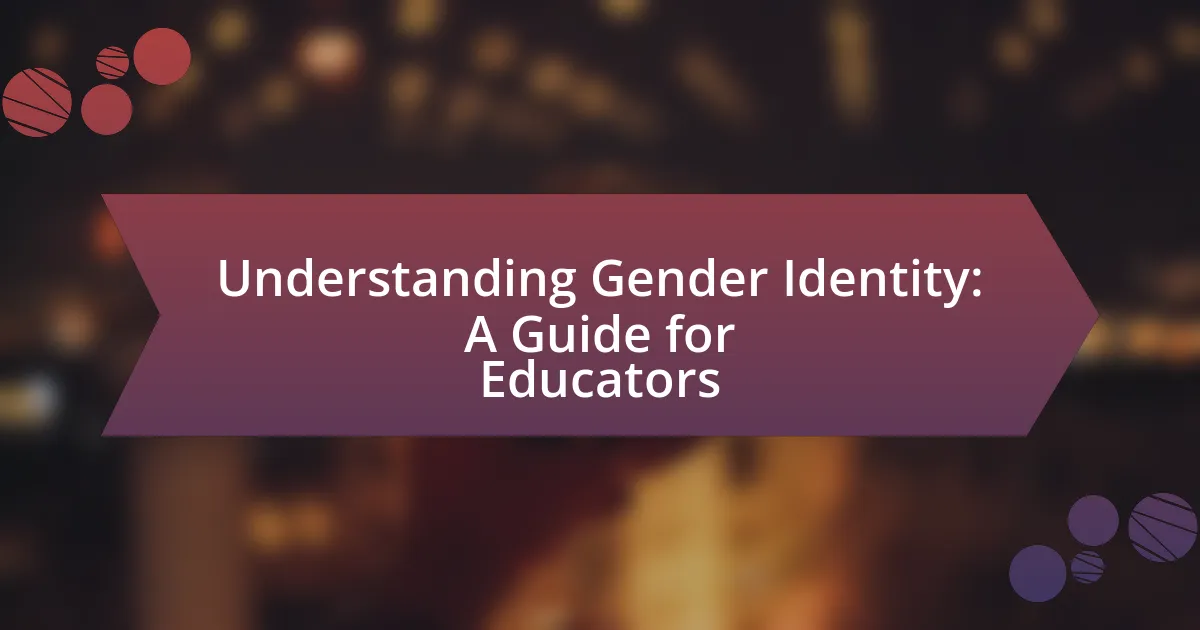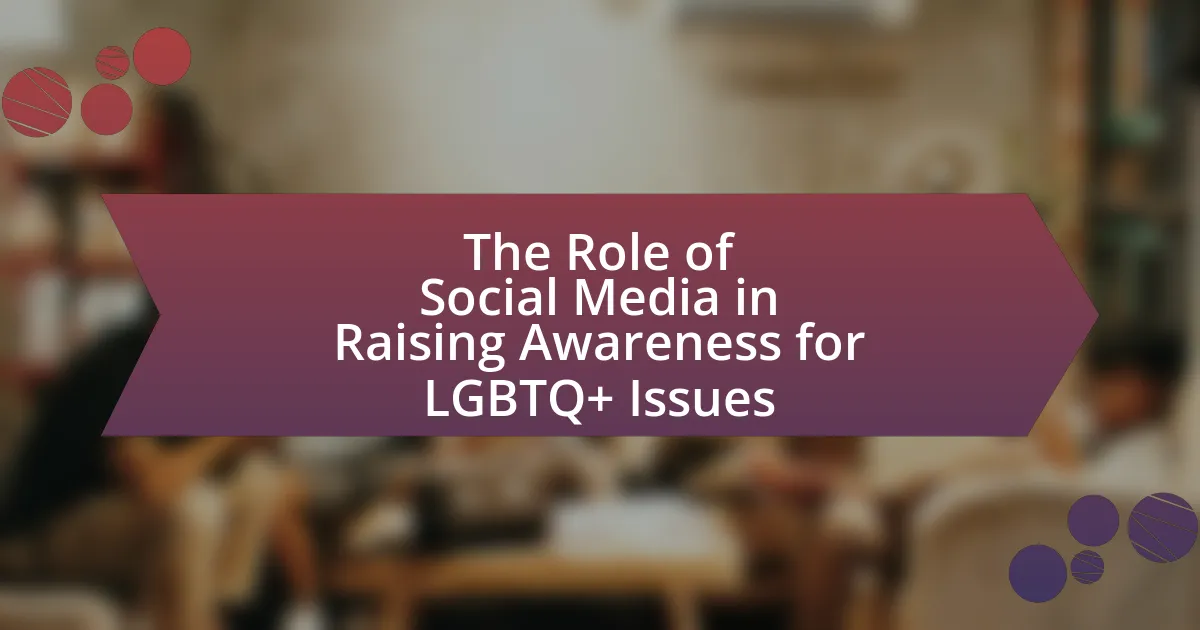The article examines the intersection of LGBTQ+ rights and racial justice in education, highlighting the unique challenges faced by LGBTQ+ students of color due to systemic racism and homophobia. It discusses how these intersecting identities lead to higher rates of bullying, lower academic achievement, and increased dropout rates. The article emphasizes the importance of inclusive policies and practices that address both LGBTQ+ rights and racial justice to create equitable educational environments. Additionally, it explores historical events that have shaped these movements, current challenges, and strategies for promoting equity in education, including the role of community organizations and advocacy efforts.

What is the Intersection of LGBTQ+ Rights and Racial Justice in Education?
The intersection of LGBTQ+ rights and racial justice in education refers to the overlapping struggles for equality faced by LGBTQ+ individuals, particularly those from racial and ethnic minority backgrounds, within educational systems. This intersection highlights how systemic racism and homophobia can compound discrimination, leading to unique challenges such as higher rates of bullying, lower academic achievement, and increased dropout rates among LGBTQ+ students of color. Research indicates that inclusive policies and practices that address both LGBTQ+ rights and racial justice can create safer and more equitable educational environments, ultimately benefiting all students. For instance, the 2019 National School Climate Survey found that LGBTQ+ students of color reported higher levels of victimization and discrimination, underscoring the need for targeted interventions that address these intersecting identities.
How do LGBTQ+ rights relate to racial justice in educational settings?
LGBTQ+ rights and racial justice in educational settings are interconnected as both movements seek to dismantle systemic discrimination and promote equity for marginalized groups. Educational institutions often reflect broader societal inequalities, where LGBTQ+ students of color face compounded discrimination based on both their sexual orientation and race. Research indicates that students who identify as both LGBTQ+ and part of a racial minority experience higher rates of bullying, mental health issues, and academic challenges compared to their peers. For instance, a study by the Gay, Lesbian & Straight Education Network (GLSEN) found that LGBTQ+ students of color reported feeling less safe in school environments, highlighting the need for inclusive policies that address both LGBTQ+ rights and racial justice to create supportive educational spaces.
What historical events have shaped the intersection of these rights in education?
The historical events that have shaped the intersection of LGBTQ+ rights and racial justice in education include the Civil Rights Movement of the 1960s, the Stonewall Riots of 1969, and the subsequent development of policies aimed at inclusivity in schools. The Civil Rights Movement, which sought to end racial segregation and discrimination, laid the groundwork for later advocacy for LGBTQ+ rights by emphasizing equality and justice. The Stonewall Riots marked a pivotal moment in LGBTQ+ activism, leading to increased visibility and demands for rights, including in educational settings. Additionally, landmark legislation such as Title IX, enacted in 1972, prohibited sex-based discrimination in federally funded education programs, which has been interpreted to include protections for LGBTQ+ students. These events collectively highlight the ongoing struggle for both racial and LGBTQ+ equity in education, demonstrating how historical advocacy efforts have influenced current policies and practices.
How do systemic inequalities impact LGBTQ+ students of color?
Systemic inequalities significantly impact LGBTQ+ students of color by exacerbating their experiences of discrimination and marginalization in educational settings. These students often face compounded challenges due to the intersection of their racial and sexual identities, leading to higher rates of bullying, lower academic achievement, and increased mental health issues. For instance, a study by the Gay, Lesbian & Straight Education Network (GLSEN) found that LGBTQ+ students of color reported feeling less safe in school compared to their white LGBTQ+ peers, with 60% experiencing harassment based on their sexual orientation and 50% based on their race. This dual discrimination not only affects their educational outcomes but also contributes to a hostile school climate that undermines their overall well-being.
Why is it important to address both LGBTQ+ rights and racial justice in education?
Addressing both LGBTQ+ rights and racial justice in education is crucial because it fosters an inclusive environment that respects and values diversity. Research indicates that students who learn in inclusive settings demonstrate higher academic performance and improved mental health outcomes. For instance, a study by GLSEN found that LGBTQ+ students who experienced supportive school climates reported lower levels of harassment and higher GPAs. Additionally, addressing racial justice ensures that the unique challenges faced by students of color are recognized and addressed, promoting equity in educational opportunities. The combination of these efforts not only enhances the educational experience for all students but also prepares them to engage in a diverse society, ultimately contributing to social cohesion and justice.
What are the consequences of neglecting these issues in schools?
Neglecting issues related to LGBTQ+ rights and racial justice in schools leads to significant negative consequences, including increased discrimination, mental health challenges, and academic underperformance among marginalized students. Research indicates that students who experience discrimination based on their sexual orientation or race are more likely to face anxiety, depression, and lower self-esteem, which can hinder their educational success. For instance, a study published in the Journal of School Psychology found that LGBTQ+ youth are at a higher risk for suicidal ideation when they lack supportive environments in educational settings. Furthermore, schools that fail to address these issues often perpetuate a culture of exclusion, resulting in lower engagement and higher dropout rates among affected students.
How can inclusive education benefit all students?
Inclusive education benefits all students by fostering a diverse learning environment that promotes understanding and respect among peers. This approach enhances social skills, as students learn to collaborate with individuals from various backgrounds, including those who identify as LGBTQ+ or belong to different racial groups. Research indicates that inclusive classrooms lead to improved academic outcomes; for instance, a study published in the Journal of Educational Psychology found that students in inclusive settings showed higher levels of engagement and achievement compared to those in traditional classrooms. Furthermore, inclusive education cultivates empathy and reduces bullying, creating a safer and more supportive atmosphere for everyone.

What are the current challenges faced at the intersection of LGBTQ+ Rights and Racial Justice in Education?
Current challenges at the intersection of LGBTQ+ rights and racial justice in education include systemic discrimination, lack of inclusive curricula, and inadequate support for marginalized students. Systemic discrimination manifests through policies that disproportionately affect LGBTQ+ students of color, leading to higher rates of bullying and mental health issues. Additionally, many educational institutions fail to implement inclusive curricula that represent diverse identities, which can alienate both LGBTQ+ students and students of color. Furthermore, support systems, such as counseling and resources, are often insufficient or culturally insensitive, exacerbating the challenges faced by these students. According to the 2021 National School Climate Survey by GLSEN, LGBTQ+ students of color reported higher levels of victimization and lower levels of support compared to their white counterparts, highlighting the urgent need for intersectional approaches in educational policies and practices.
What specific barriers do LGBTQ+ students of color encounter in schools?
LGBTQ+ students of color encounter multiple specific barriers in schools, including discrimination, lack of representation, and inadequate support systems. Discrimination manifests through bullying and harassment based on both sexual orientation and race, leading to a hostile educational environment. Research from the Gay, Lesbian & Straight Education Network (GLSEN) indicates that LGBTQ+ students of color experience higher rates of victimization compared to their white LGBTQ+ peers. Additionally, the lack of representation in curricula and school staff fails to affirm their identities, contributing to feelings of isolation. Furthermore, inadequate support systems, such as insufficient access to counseling and resources tailored to their unique experiences, exacerbate their challenges, as highlighted in the 2019 National School Climate Survey by GLSEN.
How do policies affect the experiences of these students?
Policies significantly shape the experiences of LGBTQ+ students of color by influencing their access to inclusive educational environments and resources. For instance, anti-discrimination policies can create safer school climates, reducing bullying and harassment, which is crucial for the mental well-being of these students. Research from the Gay, Lesbian & Straight Education Network (GLSEN) indicates that schools with comprehensive anti-bullying policies report lower levels of victimization among LGBTQ+ students. Furthermore, policies that promote diversity training for educators can enhance cultural competency, leading to more supportive interactions and academic success for students from marginalized backgrounds. Thus, the presence or absence of such policies directly impacts the educational experiences and overall well-being of LGBTQ+ students of color.
What role does bullying play in the educational experiences of LGBTQ+ students of color?
Bullying significantly negatively impacts the educational experiences of LGBTQ+ students of color by contributing to a hostile learning environment that affects their academic performance and mental health. Research indicates that these students face higher rates of bullying compared to their peers, leading to increased absenteeism, lower grades, and a higher likelihood of dropping out of school. For instance, a study by the Gay, Lesbian & Straight Education Network (GLSEN) found that 59% of LGBTQ+ students reported feeling unsafe at school due to their sexual orientation, and 50% due to their gender expression. This pervasive bullying not only hinders their educational attainment but also exacerbates feelings of isolation and depression, further complicating their educational journey.
How do educators and institutions respond to these challenges?
Educators and institutions respond to the challenges at the intersection of LGBTQ+ rights and racial justice by implementing inclusive curricula and policies that promote equity and representation. For instance, many schools have adopted anti-discrimination policies that explicitly protect LGBTQ+ students and staff, fostering a safer environment. Research from the Gay, Lesbian & Straight Education Network (GLSEN) indicates that schools with inclusive curricula see improved student outcomes, including higher attendance and lower dropout rates. Additionally, professional development programs for educators focus on cultural competency and LGBTQ+ issues, equipping them to address biases and support diverse student populations effectively.
What training do educators receive regarding LGBTQ+ and racial justice issues?
Educators receive training on LGBTQ+ and racial justice issues through professional development programs that focus on inclusive practices and cultural competency. These programs often include workshops, seminars, and online courses designed to enhance educators’ understanding of the unique challenges faced by LGBTQ+ students and students of color. For instance, the Human Rights Campaign provides resources and training modules that address the intersectionality of these identities, emphasizing the importance of creating safe and affirming school environments. Additionally, research indicates that comprehensive training can lead to improved student outcomes, as educators become better equipped to support diverse student populations.
How effective are current policies in promoting equity for LGBTQ+ students of color?
Current policies are often insufficient in promoting equity for LGBTQ+ students of color. Research indicates that while some policies aim to address discrimination, they frequently lack comprehensive enforcement mechanisms and fail to address the unique challenges faced by this demographic. For instance, a study by the Human Rights Campaign found that LGBTQ+ students of color experience higher rates of bullying and discrimination compared to their white counterparts, highlighting the inadequacy of existing policies. Additionally, many schools do not implement training for staff on cultural competency and intersectionality, which further undermines the effectiveness of these policies in creating an equitable environment.

What strategies can be implemented to promote equity in education for LGBTQ+ students of color?
To promote equity in education for LGBTQ+ students of color, schools can implement inclusive curricula that reflect diverse identities and histories. This strategy fosters a sense of belonging and validates the experiences of LGBTQ+ students of color. Research indicates that inclusive curricula can improve academic performance and mental health outcomes for marginalized students. Additionally, training educators on cultural competency and LGBTQ+ issues is essential; studies show that teachers who are knowledgeable about these topics create safer and more supportive environments. Establishing support groups and mentorship programs specifically for LGBTQ+ students of color can also provide crucial peer support and guidance, enhancing their educational experience.
What best practices can schools adopt to support these students?
Schools can adopt inclusive curricula that reflect the diverse identities and experiences of LGBTQ+ students and students of color. Implementing training programs for educators on cultural competency and LGBTQ+ issues fosters a supportive environment. Research indicates that schools with comprehensive anti-bullying policies and support systems, such as Gay-Straight Alliances, significantly reduce harassment and improve student well-being. Additionally, providing access to mental health resources tailored to the unique challenges faced by these students enhances their academic and social outcomes.
How can inclusive curricula be developed to reflect diverse identities?
Inclusive curricula can be developed to reflect diverse identities by integrating perspectives and contributions from various cultural, racial, and gender identities into educational content. This approach involves actively involving marginalized communities in curriculum design, ensuring representation of LGBTQ+ histories and experiences alongside those of different racial and ethnic groups. Research indicates that inclusive curricula enhance student engagement and academic performance, as seen in studies like “The Impact of Culturally Relevant Pedagogy on Student Achievement” by Ladson-Billings, which highlights improved outcomes in diverse classrooms. By prioritizing diverse narratives and fostering an environment of respect and understanding, educational institutions can create a more equitable learning experience for all students.
What role do community organizations play in supporting LGBTQ+ students of color?
Community organizations play a crucial role in supporting LGBTQ+ students of color by providing safe spaces, resources, and advocacy tailored to their unique experiences. These organizations often offer mentorship programs, educational workshops, and mental health services that address the intersectionality of race and sexual orientation. For instance, studies have shown that LGBTQ+ students of color face higher rates of discrimination and mental health challenges; community organizations help mitigate these issues by fostering inclusivity and resilience. Additionally, they engage in policy advocacy to promote equitable educational environments, ensuring that the voices of LGBTQ+ students of color are heard and represented in discussions about racial and LGBTQ+ justice.
How can advocacy efforts improve the intersection of LGBTQ+ rights and racial justice in education?
Advocacy efforts can improve the intersection of LGBTQ+ rights and racial justice in education by promoting inclusive policies and practices that address the unique challenges faced by marginalized communities. These efforts can lead to the implementation of comprehensive anti-discrimination policies, which protect students from harassment based on both sexual orientation and race. For instance, research from the Gay, Lesbian & Straight Education Network (GLSEN) indicates that schools with inclusive policies report lower rates of bullying and higher levels of student well-being. Additionally, advocacy can facilitate training for educators on culturally responsive teaching that acknowledges and respects diverse identities, fostering an environment where all students feel safe and valued. By uniting LGBTQ+ and racial justice movements, advocacy can amplify voices and create a more equitable educational landscape.
What are effective ways to engage stakeholders in advocacy efforts?
Effective ways to engage stakeholders in advocacy efforts include building relationships through open communication, involving them in decision-making processes, and providing education on relevant issues. Open communication fosters trust and ensures stakeholders feel valued, while involving them in decision-making empowers them and increases their investment in the outcomes. Education on LGBTQ+ rights and racial justice in education equips stakeholders with the knowledge needed to advocate effectively. Research shows that inclusive advocacy efforts that consider diverse perspectives lead to more comprehensive and impactful outcomes, as highlighted in the report “Advocacy Strategies for Engaging Diverse Stakeholders” by the Center for American Progress.
How can students themselves advocate for their rights and needs?
Students can advocate for their rights and needs by organizing and participating in awareness campaigns, forming student-led organizations, and engaging in dialogue with school administration. These actions empower students to voice their concerns and promote inclusivity, particularly regarding LGBTQ+ rights and racial justice. For instance, research from the Human Rights Campaign indicates that student-led initiatives can significantly influence school policies and create safer environments for marginalized groups. By collaborating with allies and utilizing social media platforms, students can amplify their messages and foster community support, thereby enhancing their advocacy efforts.
What are the key takeaways for educators and policymakers regarding this intersection?
Educators and policymakers must prioritize inclusive curricula that address both LGBTQ+ rights and racial justice to foster a supportive educational environment. Research indicates that schools implementing comprehensive diversity education see improved student outcomes and reduced discrimination (GLSEN, 2020). Additionally, collaboration with LGBTQ+ and racial justice organizations can enhance resources and training for educators, ensuring they are equipped to address the unique challenges faced by marginalized students. Data from the National Center for Education Statistics shows that students in inclusive environments report higher levels of safety and belonging, which is crucial for academic success.
What actionable steps can be taken to create a more inclusive educational environment?
To create a more inclusive educational environment, schools should implement comprehensive anti-discrimination policies that explicitly protect LGBTQ+ students and students of color. These policies should include training for educators on cultural competency and LGBTQ+ issues, ensuring that all staff understand the unique challenges faced by these groups. Research indicates that inclusive curricula, which reflect diverse histories and perspectives, significantly enhance the educational experience for all students. For example, a study by GLSEN found that LGBTQ+ inclusive curricula lead to a safer school climate and improved academic outcomes. Additionally, establishing support systems such as LGBTQ+ clubs and mentorship programs can foster a sense of belonging and community. By taking these actionable steps, educational institutions can create a more equitable and supportive environment for all students.
How can ongoing dialogue be fostered around these critical issues?
Ongoing dialogue around LGBTQ+ rights and racial justice in education can be fostered through inclusive educational policies and community engagement initiatives. Implementing curricula that reflect diverse perspectives encourages discussions among students and educators, promoting understanding and empathy. Research shows that schools with inclusive policies see improved student outcomes and a more supportive environment (GLSEN, 2020). Additionally, organizing community forums and workshops that bring together various stakeholders—students, parents, educators, and activists—creates a platform for sharing experiences and addressing concerns collaboratively. This approach not only raises awareness but also builds a network of support that sustains ongoing conversations about these critical issues.
